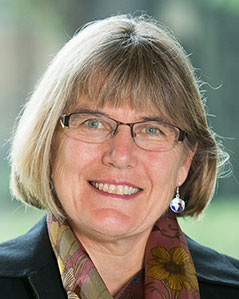Commentary on Revelation 21:1-6
Contrary to popular apocalyptic thinking, there is no “rapture” or a future snatching of Christians up from the earth in Revelation.
Instead, it is God who is “raptured” down to earth to take up residence among us. Revelation is profoundly ecological in the sense of declaring God’s commitment to the earth as the location of salvation. This Sunday’s proximity to Earth Day (April 22) occasions a rich context for proclaiming the New Jerusalem vision.
Revelation 21-22 offers us one of the most wonderful eschatological pictures in all of scripture. Readers who have followed the Lamb through the exodus journey of Revelation now are named “victors” or “conquerors” who will inherit all the promises of God (Revelation 21:7). The radiant new city fulfills Isaiah’s promises of newness (Isaiah 43:19, 65:17) as well as promises from Ezekiel and Zechariah. Promises to the seven churches come to fruition in this vision, including the Philadelphian letter’s promise to be inscribed with the “name of the city of my God, the New Jerusalem” (Revelation 3:12) and the Ephesus church’s promise of the tree of life (2:7).
Belief in a heavenly Jerusalem was widespread in biblical times (see Galatians 4:26, “Jerusalem above . . . is our mother”). What is so striking in Revelation — unlike any other Jewish apocalypse — is that this heavenly city descends from heaven down to earth.
The Lamb’s bride was introduced briefly in Revelation 19:7-9. Instead of the expected wedding scene, the bride now becomes a magnificent city, a place of welcome and renewal for God’s people. In Paul’s letters it is the church who is the bride, but in Revelation the bride is much more. The bride represents the whole renewed world, radiant and holy. God’s will “tent” (skene, skenoo, Revelation 21:3) in the midst of the bridal city. With great tenderness God wipes away people’s tears.
The vision of the city with the gleaming golden streets and pearly gates, where death and tears are no more, has given form and voice to the dreams of God’s people through the ages. African-American spirituals and gospel songs invoke imagery of the golden holy city and its river of life. From Augustine’s “City of God” through William Blake’s “Jerusalem” and Dr. Martin Luther King’s “I Have a Dream,” Revelation’s holy city has promised life and healing, reconciliation and justice.
The promise of newness — a “new heaven and new earth” — gives a radiant image of resurrection and renewal. The first earth and the sea have “passed away” (apelthon, 21:1). John’s point certainly is not that the whole cosmos will be annihilated, as some argue based on 2 Peter 3:10. The “first earth” that passes away represents the earth as captive to imperial domination and sin. The earth and all things will become “new” just as our bodies will be resurrected, renewed.
C.S. Lewis’s image “New Narnia” can be helpful for preaching Revelation’s understanding of newness in terms of both continuity and transformation. Lewis depicts New Narnia not as an escape from the old Narnia, but rather an entry more deeply into the very same place. Everything is more radiant. It is “deeper country.” New Narnia is “world within world,” where “no good thing is destroyed.”1
The repeated phrase “no more” (ouk eti) in Revelation 21:1 and 21:4 underscores all the ways God’s mystical city of beauty is the very opposite of the toxic city of Babylon/Rome (Revelation 17-18). Mourning, pain and death — all found in Babylon — come to an end in God’s holy city. John’s declaration that “the sea was no more” in 21:1 does not mean he is anti-ocean. The Mediterranean Sea was the location of Rome’s unjust trade, including slave trade condemned in the cargo list of Revelation 18:12-13. In the political economy of God’s New Jerusalem there will be no more sea-trade.
For the first time since Revelation 1:8 God speaks not through angelic intermediaries but directly, reiterating, “Behold, I make all things new.” God promises water of life for all who thirst, given free of charge. This twice-repeated promise of the water of life, dorean “without price” (21:6; 22:17), underscores the economic contrast between the political economy of God’s city and the Roman Empire. Unlike the unjust commerce of Babylon/Rome, God’s New Jerusalem is a place where life and its essentials are given as a free gift, “without money,” even to those who cannot pay for them. This vision of God’s water of life for everyone, even those without money, can be vital for preachers to proclaim in our time of economic and ecological crisis, including a global water crisis.
New Jerusalem is a profoundly urban vision, renewing our vision for urban ministry. “God wills to restore this world to a beauty we can scarcely imagine. It is a city, not a solitude, an important distinction in the narcissistic din of American culture.”2 The city that descends from heaven invites us all to enter as citizens and to “inherit” (21:7) its blessings, as God’s own sons and daughters.
1C.S. Lewis, The Last Battle (New York: Macmillan, 1956), 181.
2Kathleen Norris, Introduction to Revelation (New York: Grove Press, 1999), xii.


April 28, 2013